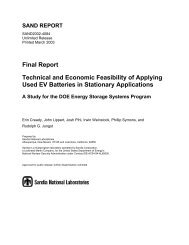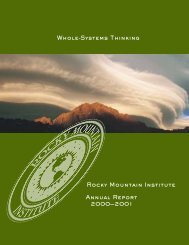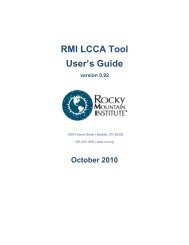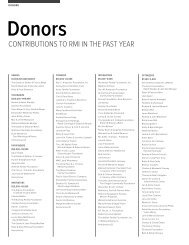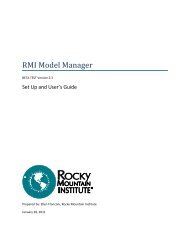Fleet Electrification Roadmap
Fleet Electrification Roadmap
Fleet Electrification Roadmap
- No tags were found...
You also want an ePaper? Increase the reach of your titles
YUMPU automatically turns print PDFs into web optimized ePapers that Google loves.
28 primer: electrification of the transportation sectorspecial sectionspecial sectionfleet electrification roadmap 29FIGURE P10Share of Energy-Related CO 2 Emissions by Fuel & UseAssessing Energy Markets over the Medium Term100%80604020100FIGURE P11Energy Related CO 2 Emissions, End Use2.5 Billion Metric Tons2.01.51.00.501950195019601960Source: Figure P10 — DOE, AER 2009; Figure P11 — DOE, AER19701970198019801990Transportation becomes the leadingsource of energy-related CO 2 emissions1990200020002009Natural Gas and WasteOther CoalElectric Power CoalOther OilTransport OilTransportIndustrialResidentialCommercialThe factors that led to high oil prices and increased volatilityin the global oil market in recent years are not likelyto significantly alter over the medium and long term.Rising demand in emerging market economies coupledwith constrained growth in oil supplies is a fundamentaldynamic that has already been factored into crude oilprices.Undeterred by the global economic downturn, Chinaclocked a 6 percent increase in oil demand in 2009 andis on pace for a 9 percent gain in 2010. 44 More broadly,emerging market energy demand growth now sets thepace for the world. In particular, the rapid increase indemand for mobility in the developing world is reshapingthe global oil market. Oil demand growth in emergingmarket economies has averaged 3.6 percent annuallysince 2000, resulting in a net increase in demand of 9.6million barrels per day between 2000 and 2009. 45 Themajority of this increase was for transportation. Oildemand in the developed world actually shrunk over thesame period. Together, China and India have accountedfor 63 percent of the total global increase in oil demandsince the start of the century. 4644 DOE, EIA, Short Term Energy Outlook, Custom Table Builder, availableonline at http://www.eia.doe.gov/emeu/steo/pub/cf_query/index.cfm,last accessed October 29, 2010.45 BP, plc., Statistical Review of World Energy 2010, at 11.46 Neil King, “An oil thirsty America dived into ‘dead sea,’” Wall StreetJournal, October 9, 2010.Emerging market demand growth is placing newpressures on oil supplies. In large part, the high level ofoil price volatility beginning in 2003 resulted from oilproducers’ inability to adequately respond to the sharpincrease in demand driven by emerging market economies.Rapidly escalating oil consumption in China, India,and the Middle East stressed the global oil productionsystem to its limits. In the meantime, resource nationalism,political instability, and insufficient upstreaminvestment in many oil producing regions led to constrainedgrowth in oil supplies. The result was a rapiderosion of spare capacity within OPEC to extremely lowlevels—less than 2 percent of global demand. 47 In suchan environment, even small perturbations or changes inmarket assessments about the balance between supplyand demand can cause sharp price swings in crude oil andretail fuels.Going forward, analysts expect oil demand growth inthe Chinese, Indian, and Middle Eastern transport sectorsto make up more than 70 percent of the increase inglobal oil consumption between 2010 and 2030. 48 Today,there are approximately 30 million light-duty vehicles onthe road in China; by 2030, analysts expect that numberto increase nearly 10-fold (see Figure P12). At the sametime, growth in global oil supplies will be tenuous. Oil47 DOE, EIA, Short Term Energy Outlook, Custom Table Builder, availableonline at http://www.eia.doe.gov/emeu/steo/pub/cf_query/index.cfm,last accessed October 29, 2010.48 IEA, WEO 2009, Table 1.3.rig—Deepwater Horizon—sank in approximately 5,000feet of water. The accident severed the rig’s connectionto the seafloor, and the blowout preventer also experienceda complete failure. While estimates vary considerably,the oil spill that resulted from the DeepwaterHorizon incident likely released several million barrelsof crude oil into the Gulf of Mexico before the damagedwell was stabilized on July 15.Like any business, the global oil and gas industry isnot risk-free. The availability of relatively inexpensiveconventional oil and gas supplies is dwindling in theregions most accessible to international oil companies—the United States, Western Europe, and industrializedAsia-Pacific. To be sure, low-cost proven oil reserves stillexist in substantial quantities, but they are most commonlylocated in countries or regions that do not permitIOCs to operate freely. As a result, IOCs have increasinglyexpanded the boundaries of technological possibilities inthe regions in which they can operate. 43Finding and developing these fuels is costly and technologicallycomplex, and deepwater oil and gas explorationis expected to be at the forefront of industry effortsto expand upstream petroleum production in the comingdecades. Significant discoveries off the coast of Brazil,Greenland, Canada, and West Africa are among thepromising opportunities to produce the fuels that drivethe global economy today—and probably will for sometime. And yet, the environmental risks associated withthese projects should be an important consideration forpolicymakers. Catastrophic oil spills are extremely lowprobabilityevents. But they are also extremely high-costevents.43 International Energy Agency (IEA), World Energy Outlook 2008 (WEO2008), Table 14.1.FIGURE P12Light Duty Vehicle Stock by Region300 Millions250200150100500European Union203020152007United StatesSource: International Energy Agency, World Energy Outlook 2009ChinaIndiaJapanRussia



